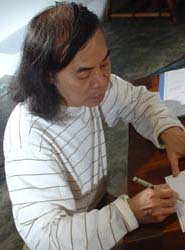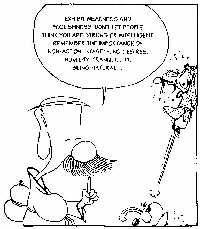
Born in 1948, Cai Zhizhong, a popular Taiwain cartoonist, was
the first to use cartoons to illustrate the seemingly recondite
ancient Chinese classics in such an amusing way. China has a wealth
of spiritual heritage, including philosophical thoughts, poems from
the Tang dynasty (618-907), the Book of Changes and
Zen Buhhdism. According to Cai, this wealth of spiritual
heritage may not be easily understood, prompting his attempts to
express these complex ideas with simple and interesting
cartoons.
Starting from the 1980s, Cai created a series of Chinese comic
books on ancient Chinese classics, like Zhuangzi Speaks: The
Music of Nature, Zen Speaks: Shouts of Nothingness,
Confucius Speaks: Words to Live By, Sunzi Speaks: The
Art of War, and The Tao Speaks: Lao Tzu's Whispers of
Wisdom. Confucius, Lao Tzu, Zhuangzi, and Sunzi are widely
credited as sages whose thoughts have played an important role in
China's development.
Cai put his unique understanding and feelings of ancient
thoughts into his cartoons, and added a modern interpretation of
them, making boring ancient philosophies quite amusing as well as
understandable. His works won a large number of adult readers for
comic books, a market predominantly children-targeted. This series
of comic books has hoarded great applause from readers both in
Taiwan and mainland China, with 4 million copies sold in
Taiwan.
Among all of his works, Zhuangzi Speaks: The Music of
Nature, published in the 1986, was the most successful.
Remaining on the top of the bestselling literature in Taiwan for
ten months, this book had quite an influence of the mainland boom
of Taiwanese literature in the late 1980s.
Cai Zhizhong's cartoons about the sayings of Confucius, Laozi,
Sunzi, Zhuangzi, and Mencius were later made into three-dimensional
cartoons.
A borderless language
Cai's works have provided him much popularity, and have been
translated into dozens of languages. Currently, readers in 40
different countries have access to Cai's works and up to 40 million
copies have been sold. More than 15 printing machines are said to
print his works each day.
Cai's latest work is the cartoon-illustrated Traditional Chinese
Culture Series. Published by Beijing-based Modern Press in June
2005, this version differs from the previous version in that the
text was written in English while the original ancient Chinese
characters were kept in the margin. Ten titles about the theories
of Tao, Confucius, and Zen Buddhism are included in this series.
The translation was done by Brian Bruya, a Ph. D. in philosophy at
Hawaii University. According to Cai, Brian's translation made his
works more understandable, further promoting his works by making
them more readable.
100 thousand copies were printed in the initial release, among
which 10 thousand were made public to readers in Taiwan, Hong Kong,
Macao, Singapore, Malaysia, Australia, North America and
Europe.
Cai hopes foreign visitors will purchase parts of his comic series
on traditional Chinese culture as souvenirs while in China. Some
worry that foreigners may not appreciate the Chinese sense of humor
in his book, but Cai thinks that cartoons are an international
language like music and dance, bearing no borders.
In addition to traditional Chinese classics, Cai published comic
books on Calculus, Algebra, and Physics in 2005. Cai was extremely
proud of himself, believing that his works would be able to arouse
students' interest in learning by making these subjects more
enjoyable.
A degage cartoonist
Cai lives a rather laid-back lifestyle, indulging himself in
whatever he likes and always feeling happy and free. He has always
emphasized doing things that he loves like cartoons and the fine
arts. He feels that the best choice in his life was selecting
"interest" as a lifelong career. He draws cartoons simply for the
intrinsic rewards it provides him, not for money or a good
reputation. He relates his job to his basic needs, and feels that
drawing cartoons is just like drinking coffee or tea when he's
thirsty.
Cai began to draw cartoons as early as middle school, and
various presses often accepted his works. At 15, he was invited by
a press in Taipei to work as a professional cartoonist. It had been
his dream for years. Cai decided to quit school for work, and when
he discussed this plan with his father, his father simply agreed
with silence. This was rather rare among Chinese parents, who are
famous for their paternalistic manner in deciding the future for
their children.
 |
Cai has a wide range of interests, from drawing cartoons to
collecting figures of Buddha, as well as playing bridge, gardening
and interior decoration. Having so many hobbies never had any
negative affects his career as a cartoonist. On the contrary, his
various other hobbies often provide inspiration. For instance, his
collection of Buddha figurines provides additional insight for his
Zen cartoons, and playing bridge is a great way to relieve the
stress associated with a lot of difficult work.
Differing from most Chinese parents, Cai has a unique way of
bringing up his daughter, stressing independence and self-reliance.
His daughter even traveled to Japan by herself at the age of 12..
With the influence of her father, his daughter has also become fond
of cartoons. Her creativity and originality is comparable to that
of her father, and many of her cartoons have been published as
well. Cai once made a comparison between human beings and wolves,
stating that a parent wolf never teaches its children the necessary
skills of survival, leaving the child with the challenge of
acquired these skills on their own.
(ChinaCulture.org June 22, 2006)
|

